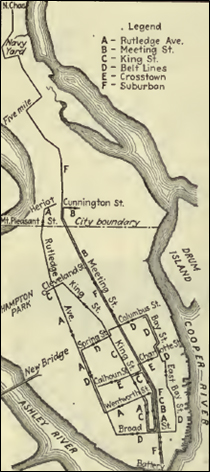 Imagine being able to get from the Battery to North Charleston in 45 minutes for 5 cents. In 1897, you could if you rode one of the Charleston Street Railway Company’s new electric “trolleys.” The word, a corruption of “to roll”, had been originally applied to early horse drawn cars and stuck when the animals were replaced by modern electric motors. The first tracks had been laid all the way to the Five Mile House in 1891 but, the new service sped up travel considerably.
Imagine being able to get from the Battery to North Charleston in 45 minutes for 5 cents. In 1897, you could if you rode one of the Charleston Street Railway Company’s new electric “trolleys.” The word, a corruption of “to roll”, had been originally applied to early horse drawn cars and stuck when the animals were replaced by modern electric motors. The first tracks had been laid all the way to the Five Mile House in 1891 but, the new service sped up travel considerably.
The early riders had usually been workers employed by lumber mills, large truck farms and numerous phosphate mills but that changed radically with the opening of Chicora Park. Bordered by Noisette Creek and the Cooper River, the urban retreat encompassed much of what had been Marshland Plantation and boasted a dance pavilion, botanical gardens and even a nine-hole golf course.
In 1901, the U.S. Navy bought the entire Park and quickly began converting the property into a shipyard and a new breed of workers crowded the cars. When World War I broke out, the shipbuilders were immediately joined by thousands of recruits from Camp Bagley. The Camp first stood between St. John’s and Spruill Avenues, and then moved across the railroad tracks into Piney Grove which was later the site of Ben Tillman Homes.

The base also boasted a uniform production plant that, for the first time, offered many women the opportunity to work outside the home. At peak periods, the two gateways at the Navy Yard handled about 4,000 to 5,000 people in one hour. The biggest rush came when the women got off at 6:35 pm and then when the men were released at 6:45 pm. The cars were heavily loaded, and the passengers took all kinds of chances in their hurry to get away. Reports at the time stated, “The women on their cars are not much better than the men, although they do not climb to the roofs or stand on the bumpers.”
After the war, and with the availability of automobiles, the trolleys quickly began to lose riders. One bright spot came on September of 1926, when they were temporarily “bought” by Kerrison’s Department store for one hour and turned over to the public for free rides in conjunction with their 95th anniversary.
 Even though they were operating in the red, the company avoided the use of buses to supplement the streetcars until January 1934, when the long line to the Navy Yard was abandoned and bus service was instituted. All other lines were eventually abandoned, as well, and the last streetcar went into the barn for the last time at 5:00 pm on February 10, 1938.
Even though they were operating in the red, the company avoided the use of buses to supplement the streetcars until January 1934, when the long line to the Navy Yard was abandoned and bus service was instituted. All other lines were eventually abandoned, as well, and the last streetcar went into the barn for the last time at 5:00 pm on February 10, 1938.
